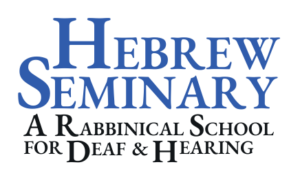The Head of the Heart, Through the Hand: Commentary on Parashiyyot Vayyakhel-Pekudey 5783
By Rabbi Jonah Rank, President & Rosh Yeshivah of Hebrew Seminary
There are three kinds of H-Jews: Head Jews, Heart Jews, and Hand Jews. So goes a teaching that has been attributed variously to two great North American rabbis: Dr. Harold Schulweis (1925–2014) and Dr. Neil Gillman (1933–2017). The Head Jew is an intellectual; the Head Jew thirsts for Torah study, for scholarship, for lectures, for books. The Heart Jew is driven by passion: the Heart Jew is moved by Jewish music, Jewish movies, Jewish prayer, Jewish food, Jewish jokes, and all things Jewish culture. The Hand Jew does not sit still; the Hand Jew is the volunteer who sets up and fold chairs at the shul, manages the office, prepares and delivers food to those in need, or even takes to the streets and demands social justice. Each of us is some kind of H-Jew.
At various points in my life, I have identified more heavily with one H-Judaism or another. Some days I feel compelled to spend more time with books, some days don’t feel right unless I have volunteered for somebody else, and some days I just want to experience the moment. Many of us have likely vacillated between these different Hs. Our identities, after all, are never so simple. We are multifaceted and shaped by many experiences in life. How could one Jew be all three Hs at the same time? It would take some sort of multitalented genius to be that consummate three-H-Jew.
The Vilna Ga’on—so named for his reputation as a ga’on (גָּאוֹן, a “genius”-leader)—located this ultimate expression of Jewish character in a group of women whose names are now lost to us. Exodus 35:25–26 recalls of these women’s contributions to the Tabernacle-in-progress:
וְכׇל־אִשָּׁ֥ה חַכְמַת־לֵ֖ב בְּיָדֶ֣יהָ טָו֑וּ וַיָּבִ֣יאוּ מַטְוֶ֗ה אֶֽת־הַתְּכֵ֙לֶת֙ וְאֶת־הָֽאַרְגָּמָ֔ן אֶת־תּוֹלַ֥עַת הַשָּׁנִ֖י וְאֶת־הַשֵּֽׁשׁ׃ וְכׇ֨ל־הַנָּשִׁ֔ים אֲשֶׁ֨ר נָשָׂ֥א לִבָּ֛ן אֹתָ֖נָה בְּחׇכְמָ֑ה טָו֖וּ אֶת־הָעִזִּֽים׃
And every woman who was smart of heart in her hands weaved. They brought a weaving of sky-blue, of purple, of worm-crimson, and of fine linen. And all the women whose heart lifted them in wisdom weaved the [hair of the] goats.
Ignoring the ambiguities of what colors and materials lied in the hands of these women, Rabbi Eliyyahu ben Shelomoh Zalman (1720–1797), writing from his perch in Eastern Europe (wherein he merited to be Vilna’s so-called genius), zeroed in on what made these women so unique. Thus he wrote in his Torah commentary Adderet Eliyyahu:
וכל אשה חכמת לב בידיה טוו וגו’. יובן בס”ד לרמוז הכוונה שקשרו וחברו חכמת הלב שהיא המחשבה עם הידים שבהם המעשה כדי לקדש עצמם במחשבה ומעשה כאחד ולא שתהיה המחשבה מופרדת מן המעשה כי האדם הפוגם במחשבתו הנה הוא מפריד המחשבה מן המעשה שתהיה מחשבתו בדבר אחר שאינו מעין המעשה והכתוב בא להגדיל קדושת מעשה המשכן שאפילו מעשה הנשים היתה בשלימות גמורה
“And every woman who was smart of heart in her hands weaved” (Exodus 35:25) should be understood, with the help of Heaven, to suggest the implication that they connected and conjoined the smartness of the heart—which is thought—with hands—wherein action [emerges]. [This was] so as to sanctify themselves with thought and action as one—so that there would be no division between thought and action. Indeed, a human who errs in one’s thought divides thought from action so that thought regarding an ‘other’ [i.e., inappropriate] matter would not be related to one’s [appropriate] action. But [our] Scripture has come to magnify the holiness of the crafting of the Tabernacle, so much so that even the action[s] of the women had been [performed] with utter perfection [accompanied by perfect thought].
The Vilna Ga’on never wrote or read in English of the three H-Jews. Like all Jews throughout history though, he idealized that rare find of a Jew whose wisdom, passions, and acts all epitomize the best of who we as Jews can become through our heads, hearts, and hands. Rabbi Eliyyahu’s commentary further suggests that there is hope for those of us who have ever felt like nobodies. Of all the great sages, prophets, sovereigns, commanders, and heroes who fill the pages of the Hebrew Bible, the supreme embodiment of Jewish living comes not in the form of a man of any renown. The best Jewish life can be lived even by somebody forgotten—and even by an entire demographic, namely Israelite women, whose history has been all but erased from our sacred literature.
We might never know the fullness of the blessings that these women offered, and we will never understand the nuances of the journeys they traveled. Our spiritual forebears nonetheless imparted to us that there are sacred ways to employ our heads, hearts, and hands—and what we do in our lifetimes may yet surpass the achievements of Judaism’s most famed protagonists. Our holiness becomes most evident when we rise to the occasion and share the talents that stem from our complex identities. When we want to, we can all be Jewish heady, hearty, and handy. There are memories within ourselves that have retreated into our past, but we can still recall them in the present and make our futures holy. No matter who we are, we reveal our Godliness whenever we find within ourselves the missing threads of our lives and weave them all together.
The weekly Torah commentary of Hebrew Seminary: A Rabbinical School for Deaf & Hearing brings new insights to students of the Torah across the world with no barriers. To help support the culture of learning Torah and teaching Torah at and beyond Hebrew Seminary, please consider making a donation today.

Leave A Comment
You must be logged in to post a comment.